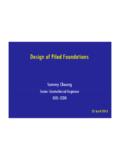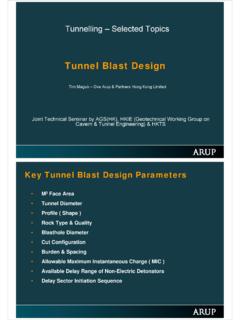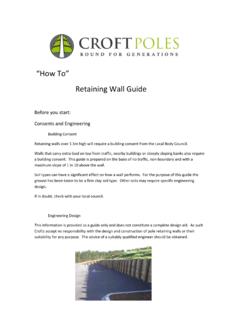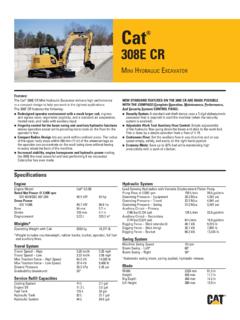Transcription of Design of Piled Foundations - hkieged.org
1 Design of Piled FoundationsSammy CheungSenior Geotechnical EngineerGeotechnical Engineering OfficeCivil Engineering and Development Department30 April 2011 Outline of Presentation Vertical Load Horizontal Load Negative Skin Friction Pile Group Instrumented Pile Test ResultsObjectives To understand the empirical nature of pile Design and the role of precedents (load tests and monitoring) To understand the role of rational Design approach and proper geotechnical input To appreciate the interaction between pile construction and pile Design To appreciate what can go wrong with different piling techniquesGeneral Perspective Ground conditions in Hong Kong are complex and can pose major challenge to piling Design and construction ( corestone-bearing weathered profiles, karstic marble, deep and/or steeply inclined rock head) Piling Design in Hong Kong is always criticized for overly conservative Design . VIVIIIIIVIIIB orehole BBorehole ABorehole log ASimplified geologyBorehole log BSimplified geologyNote :(1) Refer to Geoguide 3 (GCO, 1988) for classification of rock decomposition grade I to grade risk of using an overly simplified geological model( layered-model in corestone-bearing saprolites)General PerspectivePile Design in Hong Kong Many Hong Kong-specific deemed-to-satisfy rules are promulgated by the Authority Rules were derived through experience but are applied without geological considerations and soil mechanics principles Some rules are not conservative Unnecessarily long piles may encounter major problems during construction (so could end up as being worse off!)
2 Pile Design in Hong Kong Submissions for private and public housing projects Building (Construction) Regulations Code of Practice for Foundations , 2004 Practice Notes for AP/RSE/RGE Foundation Handbook (in preparation) Submission for public projects GEO Publication No. 1/2006 Specifications (Arch SD) Engineer s discretion on adopting standards for private submissionFoundation Design for Private Projects Buildings (Construction) Regulations AP/RSE Notes Code of Practice for Foundations (2004) deemed-to-satisfy rules more economic Design may be feasible by rational Design methodsRelevant Practice Notes for Foundation Submissionfor Private and Public Housing Projects Key PNs include: PNAP 66 (Acceptance criteria for pile testing) PNAP 161 (Scheduled Area for karstic marble) PNAP 227 (Structures On Grade on Newly Reclaimed Land) PNAP 242 (Qualified supervision) PNAP 282 (Designated Area of Northshore Lantau) PNAP 289 (Ground-borne Vibrations Arising from Pile Driving and Similar Operations) Promote use of rational Design First edition was published in 1996 Consolidate good Design and construction practice for pile Foundations , with special reference to Hong Kong s ground conditionsFoundation Design for Public ProjectsGEO Publication No.
3 1/96 Updated experience cumulated in recent years Piling data obtained from the instrumented piling load tests programme for the railway projects Expanded scope to include shallow Foundations and recent advancesFoundation Design for Public ProjectsGEO Publication No. 1/2006 Other Useful ReferencesBasic Facts about Piling Varying ground conditions involve uncertainty and risk Completed works are buried; observations and supervision during the installation process are important All forms of pile construction will affect the ground conditions -the question is by how much Different piling techniques and workmanship will affect the ground in different ways It is the behaviour of the ground after pile installation that controls pile performance (pile soil interaction) In some cases, there may be time-dependent effects that could influence the development of pile capacity in the long termPile Installation Displacement piles hammering steel or concrete into the ground with sufficient energy to refusal" Replacement piles dig a hole and fill with steel and concrete"Sounds simple, but not so!
4 Pile installation can affectpile material (damage), the ground (disturbance) andsurrounding facilitiesCommon pile types in Hong KongPile TypesTypical range of pile capacity (kN)Geotechnical load carrying capacityDisplacement PilesDriven H-piles2000 kN to 3500 kNShaft friction and end bearingDriven prestressed precast concrete piles1950 kN to 3500 kNJacked steel H-pile2950 kNJacked steel H-pile not that commonCommon pile types in Hong KongPile TypesTypical range of pile capacity (kN)Geotechnical load carrying capacityReplacement PilesSocketed H-piles3500 kN to 5300 kNShaft friction on rockAuger piles1500 kNShaft friction on soilMini-piles1400 kNShaft friction on rockMini-bored piles2000 kNShaft friction on rock and end bearingBarrettesUp to 20,000 kNShaft friction on soil and end bearing Bored pilesUp to 80,000 kN ( m bell-out)Shaft friction on soil/rock and end bearingPile Design Driven piles piles usually driven to a set based on dynamicdriving formula to match the structural capacity ( fyforsteel H piles ) Boredpiles&socketedH-piles pilesareusuallydesignedas end-bearing and limited shaft friction on rock.
5 If depth ofweathering is significant, the piles behave as friction piles instead. Need to consider geotechnical capacityand structural capacity of pilesEffects of Pile Construction on Ground Displacement piles (driven piles) - akin to cavity expansion problems, with the horizontal stresses increased and granular soils subject to densification and compaction Bored piles - stress relief effect due to hole formation; horizontal stresses in the ground reduced and ground is subject to looseningPile DesignDESIGN ISSUES Ultimate foundation capacity & overall stability Cyclic loading effects (wind, uplift) Overall settlements Differential settlements Structural Design Effects of external ground movementsPile Design Essential for a successful outcome A key geotechnical output is the values of pile stiffness (axial, lateral, rotational) for each pile within the group These can be incorporated into the structural analysis to obtain structural Design actions and also to take account of structural stiffness for settlements and differential settlements The stiffness values MUST take into account pile group interaction effectsCooperation between Geotechnical Engineerand Structural Engineer Deem-to-satisfy rules Simplified rules Code of Practice for Foundations (2004)
6 Rational Design method Based on soil/rock mechanic principles Consider geotechnical capacity and settlement May require instrumented pile loading tests to confirm Design assumption More economical Design can be achieved!Pile DesignRational Pile Design Approach An alternative to use of default values Adequate ground investigation to assist in formulation of appropriate ground model Characterization of ground properties by means of appropriate insitu and laboratory tests Proper geotechnical + engineering geological input Design analysis to be based on principles of mechanics, and/or an established empirical correlations Pile testing programme to verify Design assumptionsDesign of Axially Loaded Pile (Geotechnical Capacity)Piles found on soilP = Qs+ QB Qs= shaft capacityQB = base capacityPSoil type 1 Soil type 2 Ultimate Pile Shaft CapacityQs = sx As s= Ultimate shaft friction in each soil stratumAs= Surface area of pile shaft in each soil stratumShaft Friction in Granular SoilsTwo common Design approaches as follows:Method 1 : Effective stress method s= Ks.
7 V . tan [c is usually taken as zero]_The above may be simplified to: s= . v _[ method, where = Ksx tan ]Method 2 : Correlation with SPT N values s= fs. N_[SPT method]where N is the average uncorrected SPT N values before pile constructionKois the earth pressure coefficient at rest (viz. before pile construction) and is usually taken as (1 - sin ) for weathered rocks. Suggested KsValues for Method 1 Pile TypeKs/KoLarge Displacement Piles1 to 2 Small Displacement to to ' sis interface friction is effective angle of frictionPile Shaft Interface Friction Angle, sNote - roughness of pile/ground interface is important, but difficult to quantify in practicePile/Soil Interface s/ to to Values in saprolites and sands for Method 1 based on back analysis of local instrumented pile loading testsType of PilesType of SoilsShaft Resistance Coefficient, Driven small displacement pilesSaprolitesLoose to medium dense large displacement pilesSaprolitesLoose to medium dense piles & barrettesSaprolitesLoose to medium dense grouted bored : Only limited data for loose to medium dense sandDesign Parameters for Friction Piles- Method 2 (SPT correlation) s= fs.
8 NFor bored piles/barrettes in granitic saprolites :fstypically ranges from to [often taken to be for preliminary Design ]Pile typesUltimate Shaft FrictionDriven small displacement x SPT, max 160 kPaDriven large displacement x SPT, max 250 kPaDesign Parameters for Friction Piles- Method 2 (SPT correlation)Pile typesShaft grouting?Ultimate Shaft FrictionUltimate End BearingBarrettes formed using grabYES- No Data -- No Data x SPT, max 200kPa10 x SPT, max 2000kPaBarrettes formed using SPT, max x SPT, max 200kPaBored x SPT, max x SPT, max 200kPaFriction parameters previously accepted by BD : The Design method involving correlations with SPT results is empirical in nature Level of confidence is not high particularly where the scatter in SPT N values is large. Where possible, include a loading test on preliminary pile to confirm the Design Parameters for Friction Piles- Method 2 (SPT correlation) r v r Factor Affecting Shaft FrictionPile Shaft Changes of radial effective stress affects the skin friction Displacement piles increases in radial stress Replacement piles decrease in radial stress =( ho + h )tan =( hf )tan ho is the locked-in effective horizontal stress after pileconstruction h is the change of horizontal stress after pile construction hf is the effective horizontal stress at failure and will beaffected by.
9 Interface dilation/compression under constant stiffnesscondition during pile loading which can increase (due todilation of a dense soil), or reduce (due to compressionof a loose soil)Factor Affecting Shaft FrictionFactors Affecting Shaft Friction of Bored Piles Reduction in confining stress in bored piles Stress relief Arching effect Loosening of soil due to poor construction control Reduction in friction angle Presence of weak materials at pile/soil interface ( bentonite filter cake) Loosened/disturbed soilKey Non-Geotechnical Factors Affecting Behaviour of Bored Piles Rate of concrete pour Fluidity of concrete Time of pile bore being left open prior to concreting (- generally better to minimize the wait time to avoid excessive relaxation)Note: Faster concreting process will help to achieve higher wet concrete pressure, which would help to achieve higher locked-in horizontal stresses in the groundDistribution of Wet Concrete Pressure05010015005010015030025020001020 3040455152535 Concrete Pressure (kPa)Concrete Pressure (kPa)Depth (m)2 hr4 hrSet = 6 hr2 hr4 hrSet = 6 hrRise = 8 m/hrRise = 12 m/hrSwelling of granitic saprolite due to stressrelaxation* Important to ensure sufficient excess slurry head within pile Effective Stress (kPa)Radial strain (%)anisotropic 3 1 decreasingconstantSwelling Effect due to Stress RelaxationGood Practice for Enhancing Shaft Friction in Bored Piles Sink casing in advance of excavation to prevent loosening of soil/stress relief Maintain a high hydraulic head inside temporary casing Adopt a longer setting time for concrete Wet concrete will exert an outward fluid pressure against the drill shaft (minimize stress relief)
10 Horizontal stress hthat can be restored after excavation may be controlled by concrete pressure Avoid delay in construction to minimize potential of stress relief minimize delay in concreting after excavation avoid unnecessarily over-cleansing of pile base (delay concreting) Shaft grouting grout pressure increase horizontal stress improve strength of interface material hence shaft frictionGood Practice for Enhancing Shaft Friction in Bored PilesQB= qbx AbUltimate End-bearing Capacityqb= Ultimate end bearing pressureAb= Bearing area of pile baseUltimate Bearing Capacity of Piles in Granular Soilsqb= Nq vqb= fb Nbqb= presumptive bearing pressure (b) Empirical correlation with SPT(a) Classical bearing capacity theory(c) Presumptive bearing pressureRelationship between Nqand '(Poulos & Davis, 1980)For driven piles, ' =For bored piles, ' = '1 3 where '1is the angle of shearing resistance prior to of Shearing Resistance, ' ( )Bearing Capacity Factor, Nq 1+ 101520 Coarse sandFine sandNormally consolidated siltCoarse sandFine sandDriven pilesBored pilesDepth in bearing stratumBase diameterUltimate End Bearing CapacitySPT NbValuePile LengthBase diameter 15 Ultimate Bearing Capacity of Piles in Granular SoilsBased on SPT N Base Diameter (m)Reduction Factor, frUltimate Bearing Capacity of Piles in Granular SoilsBased on SPT N sandMedium dense sandDense Mobilised Average Shaft Resistance, max(kPa) = = = = = = 2P20P5P10P8P12P17B6CB4B7CB2P21 1P4P13P1P2B3P22P18B1B6TC3B7TB8T050100150 2002500100200300400500600700 Mean Vertical Effective Stress, 'v (kPa)B9B11B10 Figure A1 of GEO Publication 1/2006 Local Instrumented Test Data for Bored Piles /N = /N = Mobilised Average Shaft Resistance, max(kPa)










